Tilicho Lake Trek
- 16 Breakfast
- 12 Lunch
- 13 Dinner
- 3-night hotel
- 13-night eco-lodge
- Trekking
- Sightseeing
- Scenic Drive

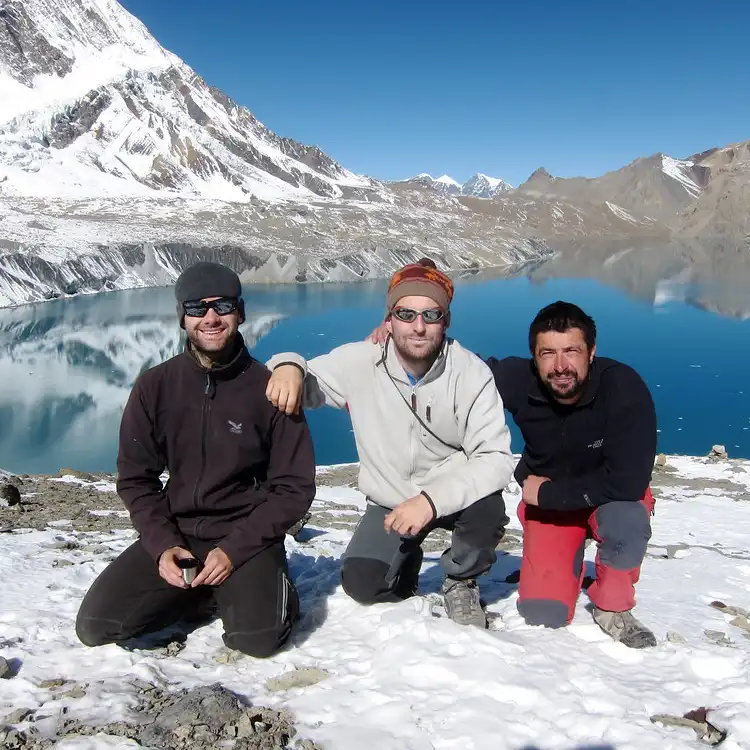
Tilicho Lake Trek offers an exhilarating adventure in Nepal’s Annapurna region, leading to one of the highest lakes globally. Trekkers experience a unique mix of natural beauty and cultural richness, with views of stunning landscapes, traditional villages, and towering peaks. This trek is both challenging and rewarding, making it a favorite among avid trekkers.
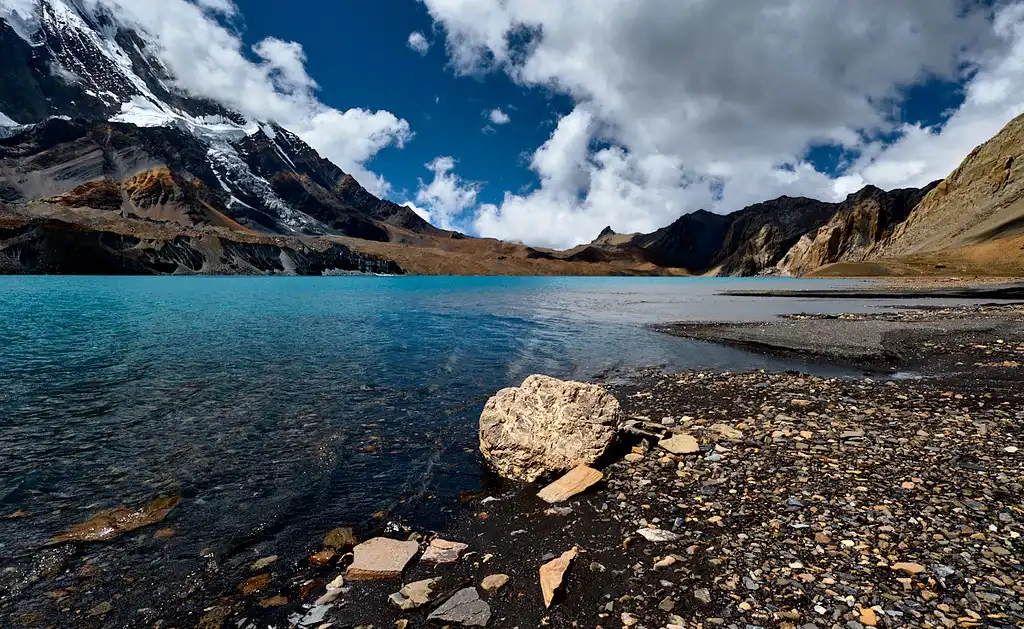
Standing at an altitude of 4,949 meters, Tilicho Lake holds the title of the highest lake in the world. This pristine lake, encircled by majestic mountains, provides a breathtaking view. The trail to Tilicho Lake takes trekkers through varied terrains, including lush forests, arid landscapes, and glacial moraines. Due to the high altitude of Tilicho Lake, proper acclimatization is essential to prevent altitude sickness.
Tilicho Lake lies in the Manang district of Nepal, nestled within the Annapurna range. The trek starts in Kathmandu and passes through several picturesque villages like Manang and Khangsar, each offering a glimpse into local culture and lifestyle. This trek not only showcases stunning natural beauty but also provides enriching interactions with local communities.
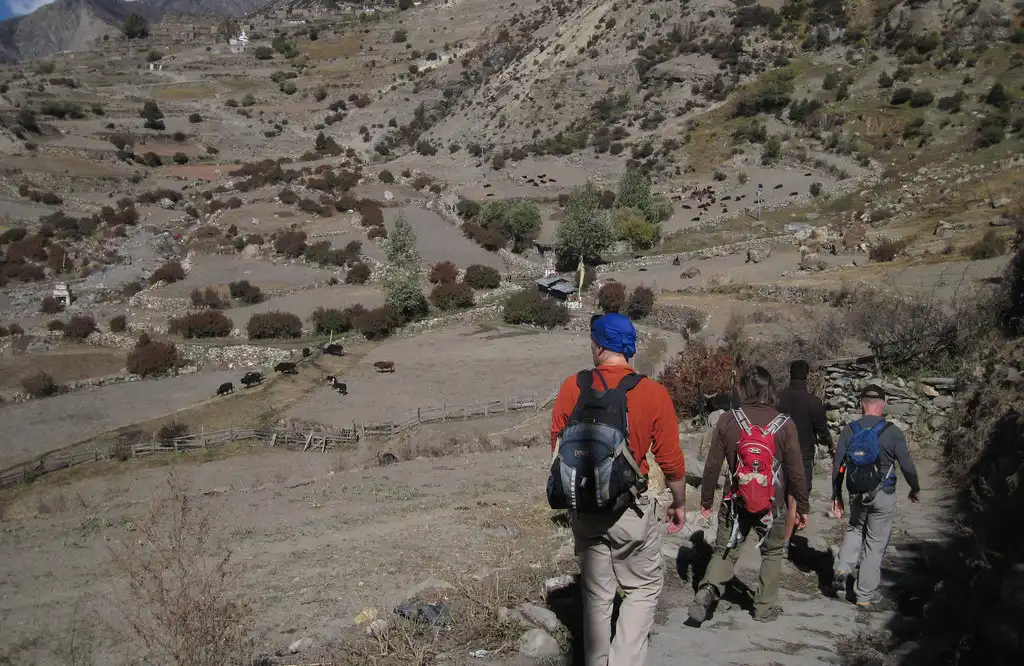
walk towards Tilicho lake
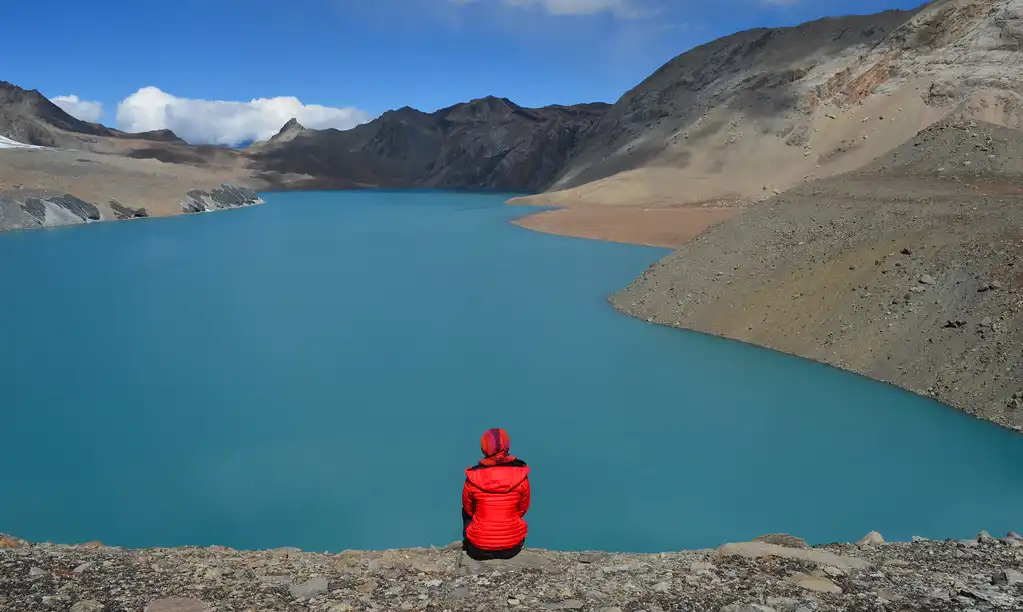
At Tilicho Lake
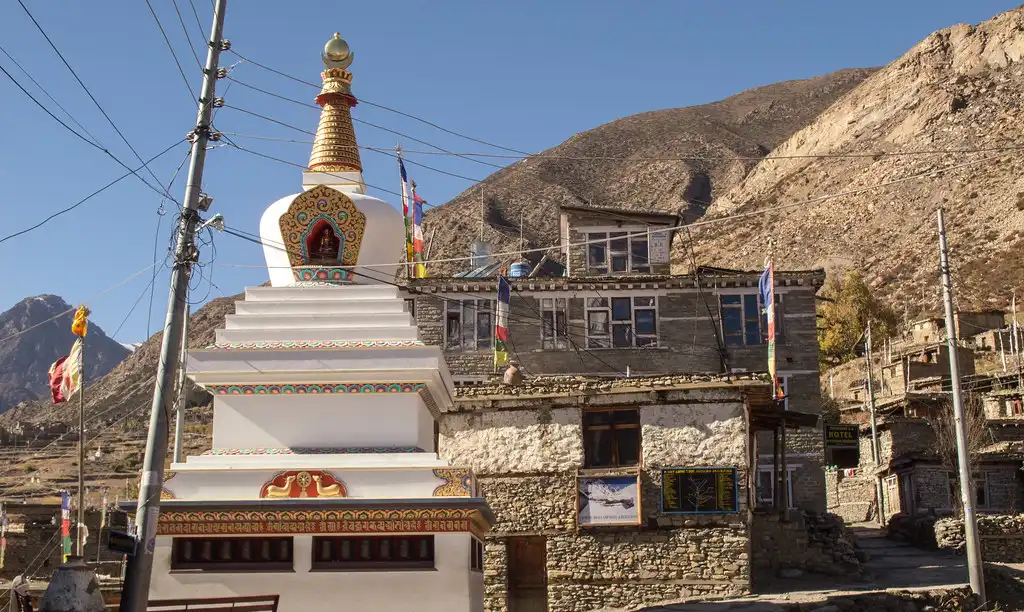
Manang village
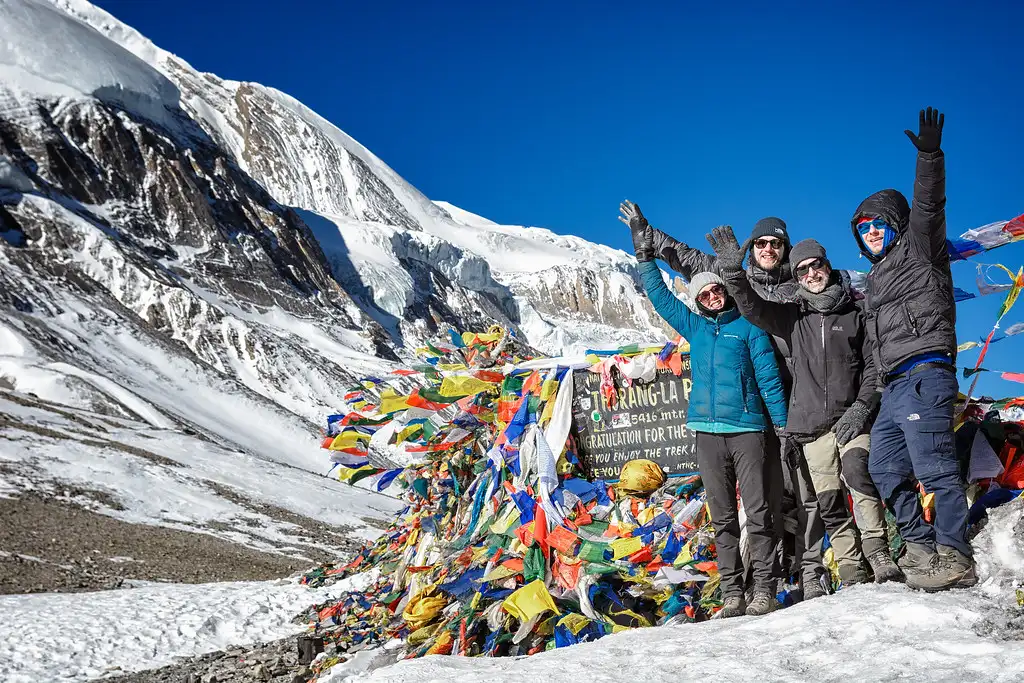
Thorong La Pass
After arriving in Kathmandu, you’ll head to your hotel for a comfortable stay. Use this time to rest and recover from your trip. If you feel up to it, explore the lively streets of Thamel, a bustling area known for its shops, restaurants, and cultural sites. Thamel provides an excellent opportunity to soak in the vibrant atmosphere of Nepal’s capital.
If you prefer a quieter start, relax at the hotel and prepare for the trek. This day is perfect for settling in and getting acclimated to the new surroundings, ensuring you’re well-rested and ready for the adventure ahead.
Start your day early with a scenic drive from Kathmandu. Enjoy diverse landscapes as you pass rivers, terraced fields, and traditional villages, giving you a glimpse into rural Nepalese life. Stop midway for lunch to break up the trip.
Continue the drive with increasingly captivating views of waterfalls and cliffs. By late afternoon, arrive in Chamje, where you’ll settle into a teahouse for the night, gearing up for the trek ahead.
Begin your trek from Chamje, crossing suspension bridges and following the Marsyangdi River. Trek through lush forests, enjoying the tranquil surroundings and vibrant greenery.
Continue through several small settlements, each offering a unique glimpse into local life. The sound of the river provides a soothing backdrop to your trek.
Encounter stunning mountain views, waterfalls, and picturesque riverbanks throughout the day. By late afternoon, reach Dharapani and settle into a teahouse for the night, ready for the next day’s adventure.
Trek through dense pine and fir forests, feeling the cool mountain air as you cross several rivers. The rugged terrain adds a challenge, but the breathtaking views make it worthwhile.
As you get closer to Chame, you’ll catch your first glimpses of Annapurna II and other peaks. The trail becomes more scenic, rewarding you with picturesque views. Notice the charming apple farms that dot the area, adding to the beauty of the surroundings.
Arrive in Chame by late afternoon. Settle into your teahouse for the night, enjoying the serene atmosphere and preparing for the next day’s trek.
Begin your day trekking through a narrow, steep valley, crossing multiple suspension bridges that offer stunning views of the river below. The morning trek is invigorating, surrounded by the natural beauty of the valley.
Reach Dhukur Pokhari, where you can take a well-deserved lunch break. The trail flattens out after lunch, making for a more relaxed trek and allowing you to fully appreciate the beautiful mountain views.
Continue towards Pisang, with the views of the surrounding peaks becoming more expansive. Arrive in Pisang by evening, settle into your teahouse, and rest up for the next leg of your trek.
Trek through Upper Pisang for better views or Lower Pisang for a shorter route. The trail winds through beautiful pine forests, offering fresh mountain air and stunning scenery. Upper Pisang provides expansive views of Annapurna and surrounding peaks.
As you proceed, the landscape opens up with breathtaking views of the Annapurna range. Pass by several small villages, each offering a glimpse into local life and Tibetan culture. The higher elevation and changing scenery make this part of the trek particularly memorable.
Reach Manang by late afternoon and settle into a teahouse for the night. Manang offers stunning mountain views and rich cultural experiences, making it an ideal place to rest and acclimate.
Spend the day in Manang to acclimate to the high altitude. Opt for hikes to Gangapurna Lake, Ice Lake, or Milarepa Cave. These hikes provide spectacular views and help your body adjust to the altitude.
Visit the Himalayan Rescue Association for tips on dealing with altitude sickness and learn more about the local culture and geography. Manang is a vibrant village that blends traditional Tibetan culture with stunning natural beauty.
Use this day to rest and prepare for higher elevations. The cultural insights and natural beauty of Manang make it a rewarding place to spend an extra day.
Leave Manang and trek towards Khangsar Village. The trail passes through serene alpine forests, offering scenic views. Cross the Khangsar River and enjoy the pristine beauty of the surrounding landscape.
Approaching Khangsar, the views of the Annapurna range become more prominent. The village, styled in traditional Tibetan architecture, provides a unique cultural experience.
Arrive in Khangsar by late afternoon and settle into a teahouse. The beautiful trails, river crossings, and cultural insights make this segment of the trek particularly enjoyable.
To prevent afternoon winds and possible rockfalls, set out early. Ascending steadily toward Tilicho Lake Base Camp, the path passes through tough terrain. The difficult climb is rewarding because of the breathtaking vistas of the mountains.
The landscapes and rocky trails get more spectacular as you ascend higher. The wider vistas afforded by the greater elevation highlight the area’s scenic splendor.
By late afternoon, reach Tilicho Lake Base Camp.
Settle into your teahouse and take in the stunning mountain vistas. Prepare for the next day’s excursion to Tilicho Lake Trek, the highlight of your trek.
Begin early for Tilicho Lake, the highest lake in the world. The trek involves a steep climb, but the spectacular views make the effort worthwhile. As you approach the lake, the surrounding mountains create a breathtaking panorama.
Spend time at Tilicho Lake, taking in its serene beauty and capturing photographs. The pristine waters and towering peaks offer a truly unique and memorable experience.
After enjoying the lake, return to the base camp along the same route. Reflect on the incredible sights and rest for the night at the teahouse, readying yourself for the descent the next day.
Retrace your steps from the base camp, descending through rugged terrain. The trail offers chances to spot blue sheep and other wildlife, adding excitement to your trek. The scenic views continue to impress as you make your way back.
Follow a different trail to Yak Kharka, passing through beautiful landscapes and enjoying the serene environment. The descent is more relaxed, allowing you to appreciate the natural surroundings fully.
Arrive in Yak Kharka by late afternoon and settle into your teahouse. The area’s scenic beauty and wildlife sightings make it a pleasant stop on your trip.
Set out from Yak Kharka and trek towards Thorong Phedi, a crucial stop before crossing Thorong La Pass. The trail takes you through rocky landscapes with stunning mountain views.
The trek involves a gradual ascent, preparing you for the challenging climb the next day. Take your time to adjust to the altitude and enjoy the scenery along the way.
Reach Thorong Phedi by late afternoon and settle into your teahouse. Use the evening to rest and prepare for the demanding climb over Thorong La Pass the following day. The anticipation of crossing one of the highest trekking passes in the world adds excitement to your trek.
Start early to cross Thorong La Pass, the highest point of the trek. The climb challenges you but rewards you with breathtaking views from the top. The long and steep descent to Muktinath showcases stunning landscapes, making the effort worthwhile.
As you descend, the terrain shifts, revealing the sacred site of Muktinath. This area, rich in culture and spiritual significance, attracts pilgrims from around the world. Take some time to stroll about the temples and take in the serene ambiance.
Arrive in Muktinath by late afternoon and settle into your teahouse. This day’s trek, one of the most demanding, also offers a profound sense of accomplishment and awe.
Trek to Jomsom, passing through ancient monasteries and the beautiful landscapes of Jharkot and Kagbeni. These villages provide a unique glimpse into local culture and traditions.
The trail gradually descends, offering views of the Kali Gandaki River and surrounding mountains. Compared to the previous day, this trek is relatively easier, allowing you to enjoy the scenery and local sights.
Arrive in Jomsom by late afternoon. Settle into your teahouse and explore the area, known for its wind-swept landscapes and vibrant community life.
Take a morning flight from Jomsom to Pokhara, enjoying stunning aerial views of the Annapurna and Dhaulagiri ranges.
Upon arrival in Pokhara, spend the day exploring the city’s lakes, caves, and bustling markets. Pokhara’s beautiful scenery and relaxed atmosphere make it a great place to unwind after the trek.
Stay at a hotel in Pokhara, enjoying the city’s comforts and reflecting on the incredible trip you have completed.
Drive back to Kathmandu, savoring the scenic route through Nepal’s diverse landscapes. The drive takes you past rivers, hills, and small villages, offering a final taste of the country’s natural beauty.
Spend the afternoon in Kathmandu, exploring or relaxing in the capital. Visit any remaining sights or enjoy the vibrant atmosphere of the city.
Stay at a hotel in Kathmandu, preparing for your departure the next day. Reflect on the highlights of your trek and the memories you’ve made.
Transfer to the airport for your departure. Reflect on the incredible trip you have completed and the stunning landscapes and cultures you’ve experienced.
During the Tilicho Lake Trek, you’ll stay in teahouses, which are basic yet comfortable lodges offering essential amenities like a bed, pillow, and blanket. In more developed areas like Manang and Jomsom, some teahouses provide private rooms with attached bathrooms and hot showers, though these come at an additional cost.
As you ascend, the accommodations become more basic, with communal sleeping areas and limited facilities. You may socialize and enjoy the hospitality of the local family while you stay in teahouses.
They serve traditional Nepalese cuisine along the trip, along with some Western options. Typically, breakfast consists of porridge, pancakes, eggs, and Tibetan bread. You might anticipate noodles, spaghetti, momos (Pakistani dumplings), dal bhat (rice, lentil soup, and vegetable curry), and occasionally meat dishes for lunch and dinner.
In addition to food and pastries, teahouses sell hot beverages such as tea, coffee, and hot chocolate. The cuisine is straightforward but filling, meant to sustain your energy levels during the hike.
Spring stands out as one of the most favored times for the Tilicho Lake Trek. The weather is mild, with daytime temperatures ranging from 10°C to 20°C (50°F to 68°F), making it perfect for long hikes. The trails burst with color from blooming rhododendrons and other wildflowers, creating a vibrant landscape.
Clear skies dominate this season, offering spectacular views of the surrounding mountains, which are ideal for photography and enjoying natural beauty. However, the popularity of spring means crowded trails and the necessity to book accommodations in advance.
Summer aligns with the monsoon season in Nepal, bringing heavy rainfall. This rain transforms the landscape into lush greenery and fills the air with freshness, offering a unique trekking experience. However, the trails can become slippery and muddy, and the risk of landslides increases, making some parts of the trek dangerous.
Frequent rains often obscure mountain views, but those who are okay with the rain will find fewer crowds and can enjoy the solitude of the trails. It’s a great time for trekkers who prefer quieter paths and are ready for challenging conditions.
Many trekkers widely regard autumn as the best season for the Tilicho Lake Trek. The monsoon season ends with clear skies and stable weather, with daytime highs of 10°C to 20°C (50°F to 68°F). Trekkers can take advantage of the superb visibility during this time to witness breathtaking vistas of the Annapurna range and other peaks.
The trails are dry and safe, ensuring comfortable trekking conditions. Additionally, this season coincides with major Nepali festivals like Dashain and Tihar, adding a rich cultural layer to the trek. The favorable conditions attract many trekkers, resulting in crowded trails and teahouses.
Trekking becomes difficult during the winter months because of the low temperatures and snowfall in the higher altitudes. In lower altitudes, daytime temperatures range from -5°C to 10°C (23°F to 50°F), while higher altitudes can see temperatures drop significantly below freezing.
Snow covers the trails, especially the high passes, posing risks like avalanches and difficult navigation. Despite these challenges, winter trekking offers stunning snow-covered landscapes and a peaceful atmosphere with fewer trekkers. It suits those who are well-prepared for the cold and seek a quieter trekking experience.
Preparing for the Tilicho Lake Trek requires solid physical fitness and specific training to ensure a safe and enjoyable experience. This trek involves long days of hiking at high altitudes, with significant elevation changes, so it’s essential to build both your cardiovascular endurance and muscle strength.
Improve your stamina by engaging in activities like running, cycling, swimming, or brisk walking. Aim for 30-45 minutes of cardio exercise 4-5 times a week. Incorporate interval training to enhance your endurance and handle the varying intensity of the Tilicho Lake Trek. Alternating between a steady pace and short bursts of high intensity can mimic the trek’s diverse terrain.
In order to handle the high ascents and descents, concentrate on strengthening your muscles, particularly those in your legs and core. Exercises targeting your quadriceps, hamstrings, calves, and glutes, such as squats, lunges, step-ups, and calf raises, are beneficial. Additionally, include core exercises like planks and Russian twists to improve stability and balance.
Prepare for the Tilicho Lake Trek by going on regular hikes. Carry a backpack with a similar weight to what you’ll use on the trek to get accustomed to the load. Begin with shorter hikes and gradually increase the distance and elevation gain. Hike on varied terrain, including steep and rocky paths, to build your confidence and skill in different conditions.
Practicing stretching and yoga are excellent ways to improve your balance and flexibility. You can negotiate rough terrain on the Tilicho Lake Trek by practicing balancing techniques like standing on one leg or utilizing a balance board. These workouts lessen the chance of injury while increasing stability.
Prepare for high-altitude trekking by improving overall fitness and stamina, as it’s difficult to train for altitude at sea level. If possible, spend time at higher altitudes before the trek to help your body acclimate. To prevent altitude sickness on the trek, go slowly, drink plenty of water, and pay attention to your body.
During your training and the hike, make sure you are getting enough food and water. To fuel your body, consume a well-balanced meal high in healthy fats, proteins, and carbs. To stay hydrated on the trek, carry a hydration system with you and drink lots of water throughout your training.
Develop mental resilience, as it is as important as physical fitness for the Tilicho Lake Trek. Staying positive and motivated helps you push through challenging moments: practice mindfulness, meditation, or other relaxation techniques to build mental strength and focus.
Because of the steep terrain and high heights, the Tilicho Lake Trek’s difficulty level varies from moderate to difficult. Trekkers must navigate steep ascents and descents, often walking for 7-8 hours a day. The trek’s highest point, Thorong La Pass, reaches 5,416 meters, requiring good physical fitness and proper acclimatization to avoid altitude sickness.
Despite these challenges, the trek offers stunning views and a strong sense of accomplishment. Variable weather conditions further add to the Tilicho Lake Trek Difficulty. Trekkers must prepare for sudden changes, including snow and strong winds at higher altitudes. It is crucial to carry proper gear and be physically prepared for a safe and enjoyable trek.
Hiring guides and porters for the Tilicho Lake Trek greatly enhances your trekking experience by providing local expertise and reducing physical strain. Guides share invaluable knowledge about the trail, culture, and local environment, ensuring a safer and more informative trip. Porters carry your heavy gear, allowing you to focus on enjoying the trek and conserving energy for the more challenging sections.
Choose experienced and licensed professionals when hiring guides and porters. It ensures your safety and supports the local economy. Many trekking agencies in Nepal offer packages that include guides and porters, making the process easier for trekkers. By hiring these services, you contribute to sustainable tourism while making your Tilicho Lake Trek more manageable and enjoyable.
Travel insurance is essential for the Tilicho Lake Trek, covering emergencies like medical issues, trip cancellations, and evacuations. It provides peace of mind by protecting you against unforeseen circumstances such as altitude sickness, injuries, or extreme weather conditions.
Could you make sure your policy includes high-altitude trekking coverage, as standard travel insurance often only covers activities above certain elevations? With comprehensive travel insurance, you can focus on enjoying your trek, knowing you have protection in case of any emergencies.
Hikers generally start their day early on the Tilicho Lake Trek, rising before dawn to maximize daylight. After a hearty breakfast in the tea room, you’ll pack up and head out on the trail. Several hours in the morning, you will take a short break to hydrate and immerse yourself in stunning scenery, including hiking, traversing steep trails, crossing vertical bridges, climbing or descending on a variety of terrains, including great views of the Annapurna and other mountain ranges.
In the afternoon, stop for lunch at a village teahouse along the trail. After refueling, the march resumes in the afternoon, often with more challenging sections or higher elevations. By midday, you will arrive at your destination for the day, where you can sit in a tea room, relax, and explore the surrounding area. In the evening, enjoy a hot meal and share stories with fellow travelers. The combination of physical exertion, breathtaking views, and cultural encounters makes each day on the Tilicho Lake Trek a unique and rewarding experience.
To visit the Annapurna Conservation Area, you must have this permit. It provides funding for the region’s management and conservation.
Cost: NPR 3,000 (approximately USD 25) for foreign nationals; NPR 200 (approximately USD 2) for SAARC nationals.
Requirements: Provide a copy of your passport and two passport-sized photos.
This card tracks trekkers’ movements for safety and security, assisting in rescue operations and route management.
Cost: USD 20 for independent trekkers; USD 10 for trekkers with a guide or agency.
Requirements: Complete a form and provide a copy of your passport and two passport-sized photos.
The great thing about this trek is its flexibility; you can do it anytime. If you need more time, you can complete the trek much faster than the traditional route.
You can take a jeep from Kathmandu to Manang and back, reducing the travel time to 10 to 15 hours. Although this significantly shortens the trek, you still enjoy beautiful sights and adventures. This option allows you to see places you might have missed otherwise, such as mesmerizing highland villages and vibrant rhododendron forests.
For a more immersive experience, consider extending the trek. Instead of trekking from Muktinath to Jomsom, you can take a jeep to Tatopani. From Tatopani, you can reach picturesque places like Ghorepani and Poon Hill. You can then continue to Tikhedhunga, from where you can drive back to Pokhara. This extended route offers deeper insights and more breathtaking views.
The Tilicho Lake trek map offers a comprehensive view of the trekking route, highlighting essential landmarks and elevation changes. Starting from Besi Sahar, the trail guides you through diverse landscapes and traditional villages like Chame, Pisang, and Manang. The map clearly marks the path to Tilicho Base Camp and further to Tilicho Lake at 4,949 meters.
Using the Tilicho Lake trek map, you can plan your trek effectively, staying informed about distances, altitudes, and significant points of interest along the route. Additionally, the map includes alternative routes and transportation options, such as jeep routes between Kathmandu and Manang, which can shorten the trek significantly.
For those seeking to extend their adventure, the map highlights extra trails leading to Tatopani, Ghorepani, and Poon Hill. The Tilicho Lake trek map is an essential tool for both novice and experienced trekkers, providing vital information for a safe and enjoyable trekking experience.
The Tilicho Lake Trek typically costs around USD 1,700. This price includes essential services such as airport pickups and drops, accommodations in Kathmandu and Pokhara, and all meals during the trek. The package also covers transportation, including a jeep ride from Kathmandu to Jagat and back, ensuring a smoother start to the trek.
The cost includes the necessary permits, such as the Annapurna Conservation Area Permit (ACAP) and Trekkers’ Information Management System (TIMS) card. The cost also covers hiring a guide and porters, enhancing the trekking experience with local expertise, and reducing physical strain.
Other inclusions are comprehensive logistical support, such as group safety equipment and medical kits. However, optional services like personal gear rental, travel insurance, and tips for guides and porters are not included and should be budgeted separately.
The Annapurna Circuit Trek with Tilicho Lake Trek entices adventurers seeking a challenging and enriching experience in the Himalayas. This trek guides you through Nepal’s most breathtaking landscapes, encompassing towering mountain passes, expansive glaciers, and deep valleys.
Starting and ending in Besisahar, a town north of Kathmandu, the trek begins with leisurely walks through villages and fertile farmlands. The terrain gradually intensifies as you approach Thorong La Pass, towering at 5,416 meters (17,769 ft) as the trek’s apex.
Once you conquer the pass, the descent leads you to Muktinath, a sacred site revered by Hindus and Buddhists alike. From Muktinath, adventurers can opt for a detour to Tilicho Lake. Perched at an elevation of 4,919 meters (16,138 ft), reaching this pristine lake involves a demanding hike yet rewards trekkers with awe-inspiring vistas.
The Tilicho Lake Trek typically spans about 15 to 18 days. This duration includes the trek starting from Besi Sahar, passing through various villages like Chame and Manang, reaching Tilicho Lake, and often continuing to Thorong La Pass before concluding in Jomsom. The trek’s length allows for proper acclimatization and exploration of the region’s diverse landscapes and cultural heritage.
To reach Tilicho Lake from Kathmandu, start by taking a bus or jeep to Besi Sahar, which takes around 6-7 hours. From Besi Sahar, either trek or take a jeep to Chame and proceed to Manang.
The trek to Tilicho Lake begins from Manang and typically takes 3-4 days, including acclimatization. The trip involves trekking through rugged terrain and high altitudes.
From Pokhara, travel to Besi Sahar by bus or jeep, which takes approximately 4-5 hours. From Besi Sahar, follow the same route as from Kathmandu: either trek or take a jeep to Chame, then continue to Manang. From Manang, the Tilicho Lake Trek takes about 3-4 days, including time for acclimatization and exploration.
March to May in the spring and September to November in autumn are the ideal times of year for the Tilicho Lake Trek. It is ideal to trek and take in the breathtaking sights throughout these times of year because of the steady weather, clear skies, and comfortable temperatures. Spring brings blooming rhododendrons and other wildflowers, while autumn provides crisp air and unobstructed mountain vistas.
Yes, Tilicho Lake is worth visiting. Situated at an altitude of 4,949 meters, it is one of the highest lakes in the world. Trekking through traditional Nepalese villages provides a unique cultural experience, varied landscapes, and stunning vistas of the Annapurna and Dhaulagiri ranges. The tranquil splendor of Tilicho Lake and the surrounding snow-capped hills is your reward for completing the strenuous trek.
Swimming in Tilicho Lake is not recommended due to its high altitude and extremely cold temperatures. The lake is fed by glaciers, making the water temperature very low, which can be dangerous for swimmers. You can best appreciate the lake’s environment from its shores.
The cost of the Tilicho Lake Trek typically ranges from USD 1,700 to USD 2,000. This price includes permits, accommodations, meals, guide and porter fees, and transportation.
Consider additional costs such as personal gear, travel insurance, and tips for guides and porters. Prices vary depending on the trekking agency and the services included in the package.
Tilicho Lake is special because it is one of the highest lakes in the world, located at an altitude of 4,949 meters. The lake’s pristine blue waters are surrounded by snow-capped peaks, offering stunning scenery. Additionally, Tilicho Lake holds significance in Hindu mythology, attracting many pilgrims who visit the lake for its spiritual importance.
The exact depth of Tilicho Lake needs to be well-documented, but it is estimated to be quite deep due to its glacial origin and large surface area. The lake’s high altitude and glacial feeding contribute to its unique characteristics and depth.
The pass near Tilicho Lake is the Mesokanto La Pass. However, most trekkers opt for the more famous Thorong La Pass, which is part of the Annapurna Circuit and lies at an altitude of 5,416 meters. Crossing these passes provides challenging but rewarding trekking experiences with stunning panoramic views.
The Tilicho Lake Trek is considered moderate to challenging. The trek involves navigating high altitudes, steep ascents and descents, and rugged terrain.
A safe and enjoyable trek requires proper acclimatization, physical conditioning, and meticulous preparation. Trekkers need to prepare for varying weather conditions and the physical demands of the high-altitude environment.
It is not possible to travel to Tilicho Lake straight from Kathmandu by bus. You can cover the approximately 173-kilometer trip to Besi Sahar by bus from Kathmandu in about 6-7 hours. From Besi Sahar, you need to trek or take a jeep to reach Manang and then trek to Tilicho Lake.
The shortest Tilicho Lake Trek typically starts from Besi Sahar and involves taking a jeep to Manang, followed by a 3-4 day trek to Tilicho Lake. This approach reduces the overall trekking duration to about 7-10 days, depending on acclimatization and trekking pace.
To reach Tilicho Lake, start from Kathmandu or Pokhara and travel to Besi Sahar by bus or jeep. From Besi Sahar, take a jeep or trek to Chame and then to Manang; from Manang, trek to Tilicho Base Camp; and finally to Tilicho Lake. The trek involves multiple stages of travel and trekking, offering diverse experiences along the way.
Many consider Tilicho Lake to be the most beautiful lake in Nepal due to its high altitude, stunning blue waters, and breathtaking mountain scenery. Other notable lakes include Rara Lake and Gosaikunda Lake, each offering unique beauty and trekking experiences.
Tilicho Lake sits at an altitude of 16,237 feet (4,949 meters). This high elevation makes it one of the highest lakes in the world, offering spectacular views and a challenging trek.
You can find Tilicho Lake in the Manang District of Nepal. This region boasts stunning natural beauty, diverse landscapes, and significant cultural importance.
Tilicho Lake is famous for being one of the highest lakes in the world and for its stunning natural beauty. It is also known for its significance in Hindu mythology and the challenging yet rewarding trek to reach it. Both pilgrims and trekkers favor this location because of its quiet surroundings and magnificent vistas.
Swimming in Tilicho Lake is not recommended due to its high altitude and extremely cold temperatures, which can be dangerous. You can best appreciate the lake’s glacial-fed waters from the shore.
The trek from Manang to Tilicho Lake typically takes 3-4 days, including time for acclimatization. The route involves navigating through rugged terrain and high altitudes, offering stunning views along the way.
The deepest lake in Nepal is Rara Lake, which is approximately 167 meters (548 feet) deep. Situated within the Rara National Park, it is renowned for its unspoiled splendor and tranquil surroundings.
Tilicho Lake, being a high-altitude glacial lake, does not support fish due to the extremely cold temperatures and lack of suitable habitat. The lake’s environment is more suited to its unique, pristine nature rather than supporting aquatic life.

Based on 3 Reviews

I had an exceptional time on the Tilicho Lake Trek with Peregrine Treks and Tours. The breathtaking views, coupled with the well-organized trek, made for an unforgettable experience. Highly recommend this trek!

Excellent






I was blown away by the Tilicho Lake Trek with Peregrine Treks and Tours. The team took great care of us, and the trek itself was challenging yet rewarding. The scenery was out of this world!

Excellent






The Tilicho Lake Trek with Peregrine Treks and Tours was phenomenal. The natural beauty and the well-organized itinerary made it a trip to remember. A must-do for any trekking enthusiast.

Excellent





